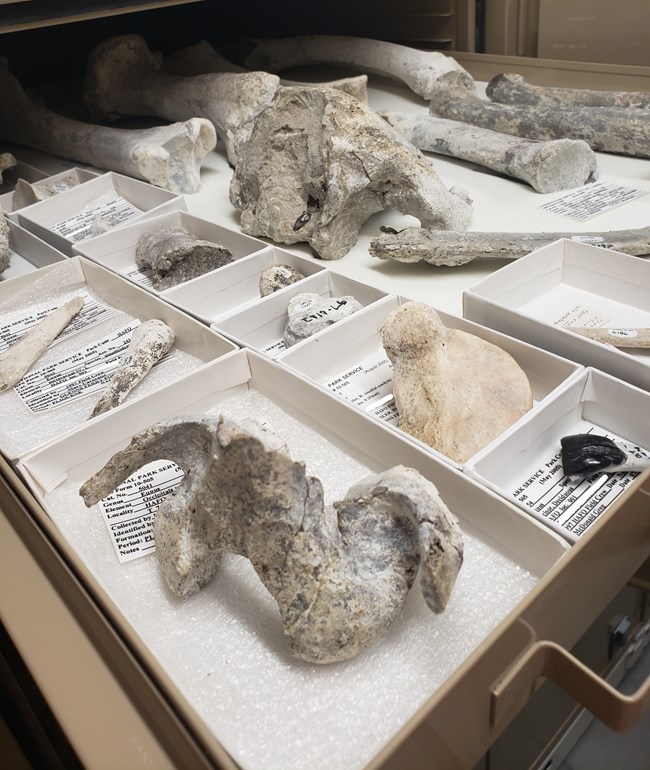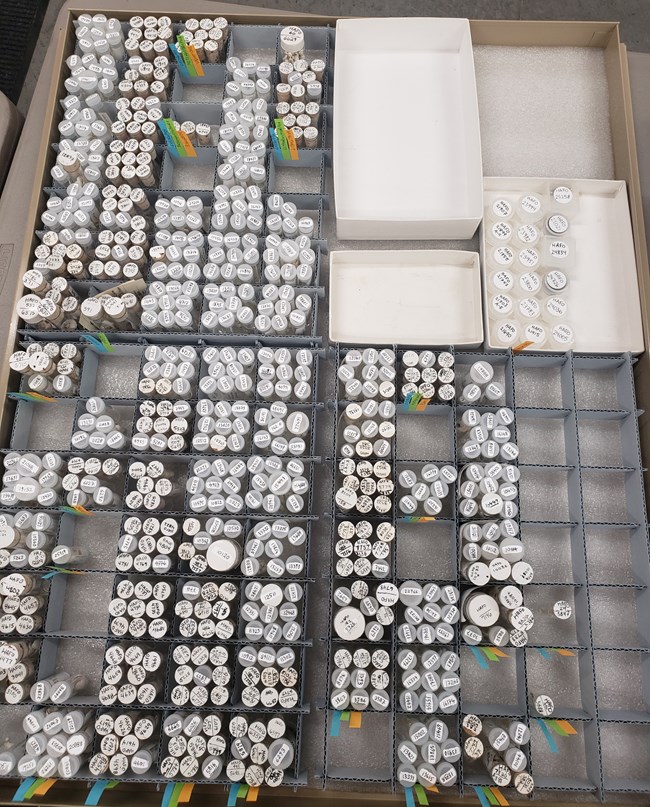Part of a series of articles titled Park Paleontology News - Vol. 14, No. 1, Spring 2022.
Article
The Importance of Paleontology Collections

Alexander Kim, Museum Technician
Hagerman Fossil Beds National Monument, Idaho

NPS photo by Alex Kim.
Why are museum paleontology collections important?
For the past three and a half billion years, the history of life on Earth has been captured in the stones beneath our feet. Paleontologists have been using fossils, lithified traces of life, to reconstruct the past conditions of our planet. These fossils range from tiny impressions left by extinct microorganisms to the enormous bones of giant animals. Only a meager percentage of life ever becomes fossilized, and smaller still is the number of those fossils recovered. Each one is a precious limited resource, many of them one-of-a-kind and irreplaceable.
Fossils provide insights that are otherwise unavailable. Without them, who could guess that giant reptiles were once the predominant form of animal life on land, or that they were preceded in abundance by the ancestors of mammals prior to the Permian extinction 250 million years ago? To preserve these resources, museum collections serve a crucial role in maintaining the physical protection and scientific integrity of paleontology specimens. While many of us have experienced fossils in exhibit spaces, the specific nuances of paleontology collections and their importance often goes undiscussed, resulting in a disconnect between public understanding and the museum’s role as an institution.
Protect and Preserve
To meet adequate standards of care for fossils specimens, certain facilities, equipment, and training are required. Fossils can vary considerably in their durability, and special precautions such as preparation work may be required to support and maintain them. Preparing fossils consists of actively extracting them from their surrounding matrix through mechanical or chemical methods, as well as reconstructing pieces that are missing or broken. Preparation is a delicate process that can take hundreds of hours depending on the specimen. These are non-renewable resources, and one mistake could potentially damage or destroy the fossil. Should a fossil be damaged, at the time of discovery, during excavation and transportation, or in the preparation process, the preparation staff are best equipped with the knowledge and tools to salvage the specimen. Similarly, the management of fossils extends beyond simply housing them. Collections staff closely monitor the condition and upkeep of the fossils through regular inventories. In some cases, potential health risks, such as off-gassing of radon, need to be accounted for and mitigated through custom equipment such as airtight cabinetry with vacuum port holes. These challenges are best met safely through the equipment and facilities available in paleontology collections spaces.

NPS photo by Alex Kim.
Facilitating Access
Perhaps the most central function of paleontology collections beyond preservation of the fossils is the facilitation of access. Many fossils are found in areas that are difficult to access or outright hazardous. Those without the ability to safely access these locations might never have an opportunity to see or study certain specimens and localities. Alternatively, some field localities could be rendered entirely inaccessible since the fossils were collected, thus making collections the best way to study that specific site. By providing access and space, paleontology collections create a more equitable experience for scientists and museum guests alike.
Interpretation of collections is another vital aspect of access, as it represents the transformation of scientific data into digestible information for public consumption. It is a skill that requires educational experience, knowledge in paleontology, and understanding of the audience. Some museums are supported largely or entirely through tourism and local communities. For these museums, explaining the value of the service provided by paleontology collections and the magnitude of scientific knowledge contained therein becomes even more imperative. While many people are generally interested in paleontology as a matter of fascination, they might wonder why resources should be invested in the continuous collection and preservation of fossils. By creating and improving the relationship between the general audience and the science of the paleontology, interpretation plays a pivotal role in the public support of collections.
Maintaining Accuracy

NPS photo by Alex Kim.
Paleontology collections provide a place for paleontologists to house specimens with the confidence that the specimen and relevant information alike are maintained with integrity and accuracy. While typically thought of as spaces designed for housing physical objects, museum collections are perhaps better reimagined as reservoirs of information and knowledge represented by the objects within. It is the responsibility of collection managers and curators to maintain accurate records so that the fossils retain as much scientific value as possible. The loss of this data, such as the locality or other specimens found within the same context, can be very damaging to paleontologists’ understanding of not only the specimen itself but the entirety of the site. Unfortunately, this is a recurring issue with many fossils collected in the fledgling years of the science. Similar issues arise when specimens are collected by hobbyists or commercial collectors who do not collect the proper metadata or might even steal from protected sites set aside for their natural resources. The fossils on national park lands fall under the protections of the Paleontological Resources Preservation Act, and permits are required for their collection.
The Science
The types of research projects based on paleontology specimens range from environmental reconstructions to functional morphology to taxonomic analyses. Aside from fossils, sediments are also frequently extracted for geochemical analyses, sometimes years after the act of collection. Accordingly, it is paramount that best collections practices are exercised in the preservation of these resources. Preserving paleontological specimens is necessary for future research to be performed, as new technologies and ideas create opportunities for novel methodologies to be employed. Many fossils in collections predate the adoption of common research techniques such as isotopic analyses and CT scanning. Paleontology is a multifaceted and interdisciplinary science; an amalgamation of geology, anatomy, ecology, and countless other fields depending on the research.
It might not be intuitive as to how paleontology benefits people beyond improving understanding and knowledge of the past. While paleontologists predominantly study the world as it existed millions of years ago, much of the research is tied directly into our understanding of the natural world today. In broad terms, why do some animals go extinct, and how might those conditions be reflected in present times? What might be the lasting impact of human-driven mass extinction, or the potential consequences of climate change? These types of questions are pertinent to the preservation of our natural resources and the survival of our modern animals.

NPS photo by Alex Kim.
In Summary
As institutions, museums are accessible ways for guests to experience fossil collections, and important resources for scientists as hubs of information. The science of paleontology continues to develop every year, with new research born out of data gathered from specimens in collections that are often older than many of the individuals working in them. The discovery and utilization of new techniques means that even the most researched fossils might still contribute to new insights. The continued preservation of these specimens is built on a foundation of best practices developed through generations of experience in paleontology collections, emphasizing not only physical integrity of the specimens, but accurate recordkeeping and attention to detail when handling metadata. Without the standard of care provided by professional paleontology collections, the scientific value of fossils as a resource dramatically declines. For these reasons, the service provided by these collections cannot be understated and warrants continued support and development.
Related Links
-
Hagerman Fossil Beds National Monument (HAFO), Idaho—[HAFO Geodiversity Atlas] [HAFO Park Home] [HAFO npshistory.com]
Last updated: May 30, 2023
